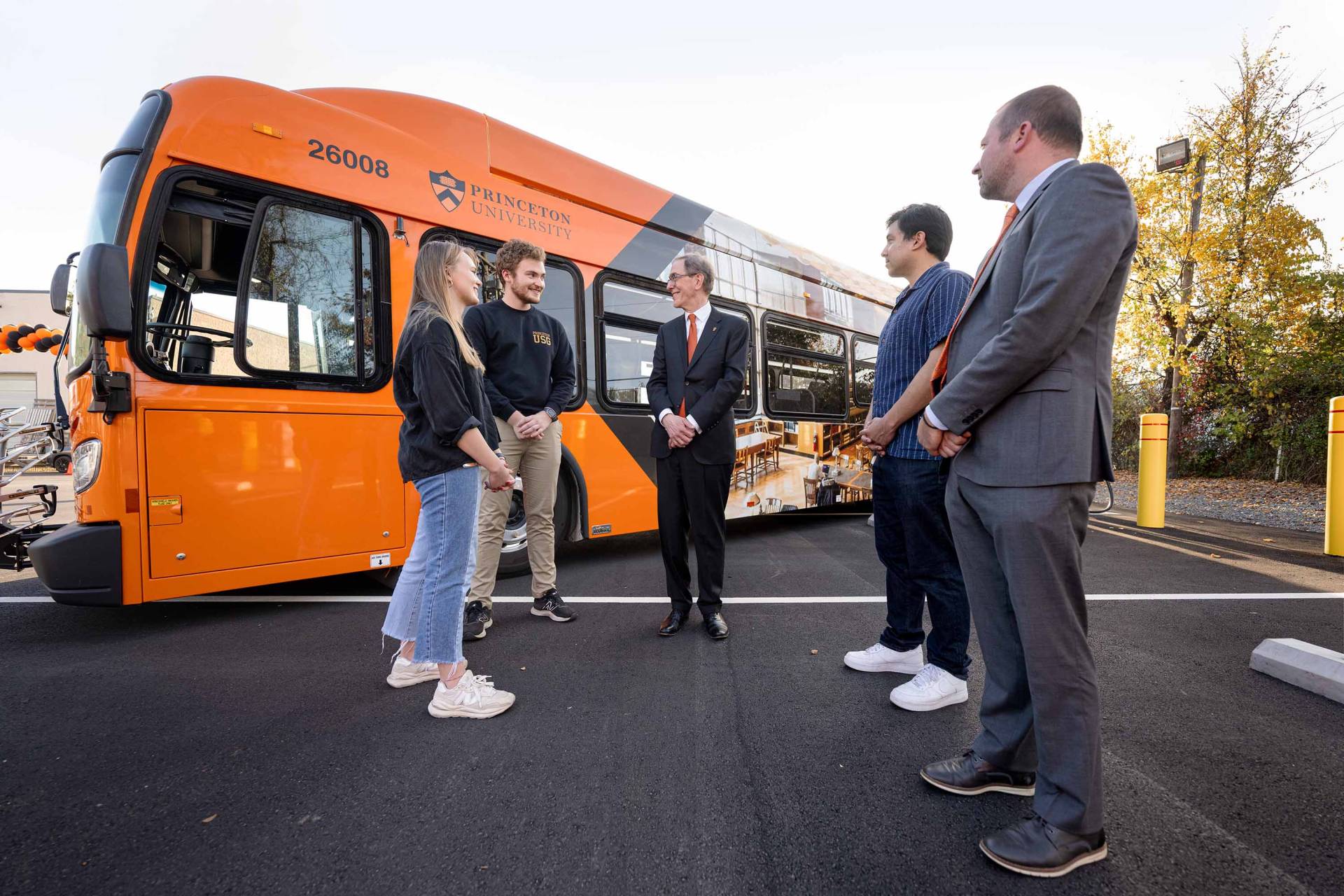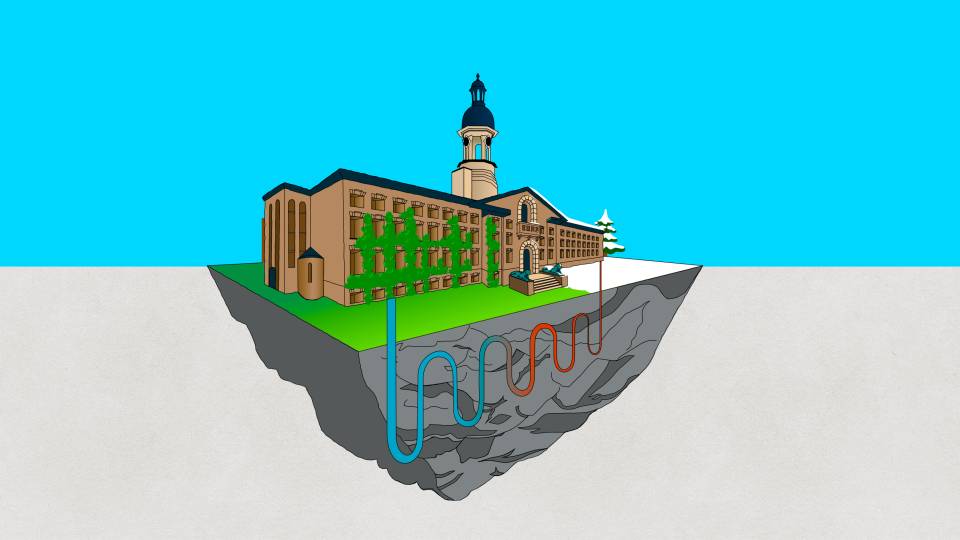Princeton’s 17 new electric buses are helping the University achieve net-zero carbon emissions by its 300th anniversary in 2046, or sooner.
Princeton University’s ambitious and influential campus plan for sustainable energy use reached another milestone this fall when the University celebrated its new fleet of electric buses and charging facilities at a grand opening ceremony Oct. 26.
“TigerTransit’s 17 new electric buses advance our campus sustainability goals [and] exemplify the changes we are pursuing as an institution and as a society,” Princeton University President Christopher L. Eisgruber said at the event, held at the University’s new bus-charging station at 755 Alexander St. in West Windsor. “They eliminate 500 metric tons of tailpipe emissions from the campus and local communities, annually. Our air is cleaner because of this project.”
The buses are part of a campus-wide plan to achieve net-zero carbon emissions that is serving as a template for other universities and municipalities across the country, including a massive geo-exchange system for campus heating and cooling.
All of Princeton’s full-size buses are now fully electric. When the last diesel mini-buses are retired later this academic year, Princeton will be the first Ivy League university and one of very few transit or shuttle operations in the country that operates only emissions-free vehicles.
“A year ago, this was gravel, tumbleweeds, and a couple of storage containers,” said Charlie Tennyson, Princeton’s director of Transportation & Parking Services, looking out at the charging station. “Today, it’s one of the largest electric transit vehicle charging facilities in the country.”

Princeton now gets nearly 20% of its campus electricity from the University’s own system of solar panels. The 5-acre array of solar panels here, situated above one of the lots where Princeton charges its EV buses, accounts for just over 10% of the University’s installed solar capacity.
More on Princeton's campus sustainability
Princeton's campus is an active laboratory for innovations in sustainability that are inspiring other campuses and cities.
- Ride along with our new electric bus fleet.
- Explore the University's Sustainability Action Plan.
- Follow our progress toward becoming a net-zero campus by 2046.
- See the nuts and bolts of our innovative geo-exchange system.
The decision to replace Princeton’s entire transit fleet with electric vehicles (EVs) was not an easy or obvious one, the University’s executive vice president, Katie Callow-Wright, noted at the ceremony.
When planning began three years ago, the decision-making process was extensive. “There really was not a playbook for us to refer to,” Tennyson said later. “Looking back, it’s amazing to think about how much time and research it took to make the choice to buy electric buses and infrastructure, and how much we learned.”
Bold bet on sustainability
Many universities and regional transit authorities have begun electrifying their bus fleets, but most decommission and replace one or a few diesel buses at a time due to operational and infrastructure constraints. As Princeton was set to decommission its former diesel fleet at once, it had the unique opportunity to electrify its entire fleet in a single effort.
In the spirit of the University’s informal motto, “in the nation’s service and the service of humanity,” Tennyson and WeDriveU, which operates the TigerTransit shuttle system, convened a summit a week before the grand opening so Princeton’s transportation team could help shorten the learning curve for peer universities and others who are considering the transition.
The summit brought together 70 representatives from more than 20 utilities, transit operators, and universities from across the country, including several Ivy League schools, Stanford University, Montclair State University, Lehigh University, New Jersey Transit, WeDriveU, Joint Base McGuire-Dix-Lakehurst, the Southeastern Pennsylvania Transportation Authority (SEPTA), Washington University in St. Louis, the University of Michigan, Genentech, and Google.
That discussion among experts knowledgeable in all aspects of bus electrification — power, planning, logistics — is what Tennyson told attendees he wished had existed three years ago, when Princeton began its journey to an all-electric fleet.
“No system can be copied exactly from one university to another, but we can share our thought processes, how we decided which equipment to use, how we worked through the challenges and logistics,” said Amanda Stevens, the assistant director for campus engagement with Transportation & Parking Services.
The day-long session included tours of the 755 Alexander St. charging station, a secondary charging station at Princeton’s Parking Lot 20 and the newly refurbished Stadium Garage, along with remarks from several leaders in net-zero research and implementation.
Debby Foster, Princeton’s deputy vice president for University Services, praised the “tireless work” by Tennyson and consultant partners like Paulo Nunes-Ueno that made the fleet conversion possible, describing how they dug into performance data, talked with industry experts and visited electric bus facilities from Westchester County, New York, to California's Bay Area.
“It was their extensive research,” Foster said, “that really gave me the confidence to go to University leadership and say, ‘Yes, this is the right system for Princeton. This is the right solution. We found the right buses. We found the right charging equipment.’ ”

President Eisgruber (center) talks at the Oct. 26 event with (from left): Alana Bernys, facilities and transportation chair for the Graduate Student Government (GSG); Stephen Daniels, president of the Undergraduate Student Government (USG); Christopher Catalano, vice president of the GSG; and Charlie Tennyson, director of Transportation & Parking Services.
Free to all, and accessible
The Xcelsior battery electric buses (XE35), manufactured by New Flyer, have a range of 120 to 200 miles and can run for 12 hours in temperate weather. They can seat 26 passengers and accommodate another 18 standing. Each bus offers 14 USB chargers to power passengers’ devices.
Ridership on the new buses is way up, even over pre-pandemic levels. September 2023 saw 60 percent more riders than September 2019. Tennyson credits the ridership increase to many factors, including better vehicles, a streamlined service plan that includes robust public engagement, and better tools and information for riders, such as publication of transit schedules to Google, better maps, and real-time arrival screens at 13 stops across the campus.
TigerTransit buses have always been free of charge for all passengers, and now the buses are broadcasting that message, with “Free Shuttle Service For All” emblazoned on both sides.
The new EV buses accommodate wheelchair passengers with best-in-class onboard technology, Tennyson said, including automated wheelchair positioning. As Eisgruber noted at the ceremony, “Accessibility, and providing a universal experience for all ages and abilities to move freely throughout our campus, is an institutional priority.”
Partners in a greener future
Eisgruber underscored the collaborative vision and effort that enabled the University’s electric bus fleet and charging stations to become a reality. “This progress is the result of a remarkable collaboration between campus and regional partners, other universities, public transit agencies and private companies,” he said.
One key partner was the community of West Windsor, which was represented at the 755 Alexander St. event by Mayor Hemant Marathe. “I couldn't be happier that it is being located in West Windsor Township, and I couldn't be happier that Princeton University is growing their presence in our township," said Marathe.
Another key partner was PSE&G, which powers the 755 Alexander St. facility. There, where Princeton’s fleet charges overnight, PSE&G and the University have installed eight chargers that can simultaneously charge 16 buses.
“At PSE&G, we take pride in our collaboration with Princeton University’s TigerTransit,” said John Latka, senior vice president for electric transmission and distribution at PSE&G. “We’re delighted to support Princeton University as one of the pioneering Ivy League transit operators in the Northeast to own and operate a fully electric bus fleet. This partnership underscores our shared dedication to a cleaner, electrified future for the state.”
The secondary charging station at Lot 20 is powered by a combination of on-site solar power, PSE&G power, and the Princeton University Energy Plant. It has two chargers that can charge up to five buses at once.
The smaller station hasn’t been needed for midday recharging yet, but that may change as the temperatures drop and the electric heaters begin to draw on the batteries, said Tennyson. “In mild weather, the bus can run a full day on a single charge, but with winter approaching, we may see top-offs becoming necessary.”
Near the secondary charging station, there will soon be electric vehicle charging ports for personal cars. As part of the University’s commitment to electrification as a vital step toward a net-zero future, Princeton currently provides 85 free EV charging ports across the campus — 65 in the Stadium Garage and 10 each in the Theater Garage and the Prospect Avenue Garage. Tennyson says that 40 more will go live in the Meadows Garage in January 2024, followed by 20 chargers in Lot 20 by the end of 2023-2024 academic year.

Many people involved in bringing the EV buses to Princeton came to celebrate at the charging facility's grand opening. From left: Richie Tisone, Stout's Transportation; Jenna Glass, the Service Point; Louis End, WeDriveU; Michael Randolph, Princeton Transportation & Parking Services (TPS); Charlie Tennyson, TPS; Amanda Stevens, TPS; Steve Stewart, WeDriveU; Debby Foster, Princeton’s deputy vice president for University Services; Praveen Rajasekaran, TPS; Lorenzo Geroso, WeDriveU; and Kevin Guilbault, TPS.






